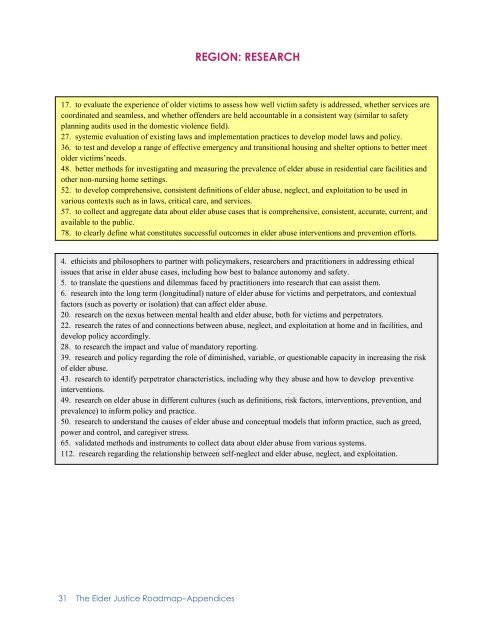The Elder Justice Roadmap
2gJRXoo
2gJRXoo
Create successful ePaper yourself
Turn your PDF publications into a flip-book with our unique Google optimized e-Paper software.
REGION: RESEARCH<br />
17. to evaluate the experience of older victims to assess how well victim safety is addressed, whether services are<br />
coordinated and seamless, and whether offenders are held accountable in a consistent way (similar to safety<br />
planning audits used in the domestic violence field).<br />
27. systemic evaluation of existing laws and implementation practices to develop model laws and policy.<br />
36. to test and develop a range of effective emergency and transitional housing and shelter options to better meet<br />
older victims’needs.<br />
48. better methods for investigating and measuring the prevalence of elder abuse in residential care facilities and<br />
other non-nursing home settings.<br />
52. to develop comprehensive, consistent definitions of elder abuse, neglect, and exploitation to be used in<br />
various contexts such as in laws, critical care, and services.<br />
57. to collect and aggregate data about elder abuse cases that is comprehensive, consistent, accurate, current, and<br />
available to the public.<br />
78. to clearly define what constitutes successful outcomes in elder abuse interventions and prevention efforts.<br />
4. ethicists and philosophers to partner with policymakers, researchers and practitioners in addressing ethical<br />
issues that arise in elder abuse cases, including how best to balance autonomy and safety.<br />
5. to translate the questions and dilemmas faced by practitioners into research that can assist them.<br />
6. research into the long term (longitudinal) nature of elder abuse for victims and perpetrators, and contextual<br />
factors (such as poverty or isolation) that can affect elder abuse.<br />
20. research on the nexus between mental health and elder abuse, both for victims and perpetrators.<br />
22. research the rates of and connections between abuse, neglect, and exploitation at home and in facilities, and<br />
develop policy accordingly.<br />
28. to research the impact and value of mandatory reporting.<br />
39. research and policy regarding the role of diminished, variable, or questionable capacity in increasing the risk<br />
of elder abuse.<br />
43. research to identify perpetrator characteristics, including why they abuse and how to develop preventive<br />
interventions.<br />
49. research on elder abuse in different cultures (such as definitions, risk factors, interventions, prevention, and<br />
prevalence) to inform policy and practice.<br />
50. research to understand the causes of elder abuse and conceptual models that inform practice, such as greed,<br />
power and control, and caregiver stress.<br />
65. validated methods and instruments to collect data about elder abuse from various systems.<br />
112. research regarding the relationship between self-neglect and elder abuse, neglect, and exploitation.<br />
31 <strong>The</strong> <strong>Elder</strong> <strong>Justice</strong> <strong>Roadmap</strong>–Appendices


